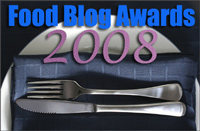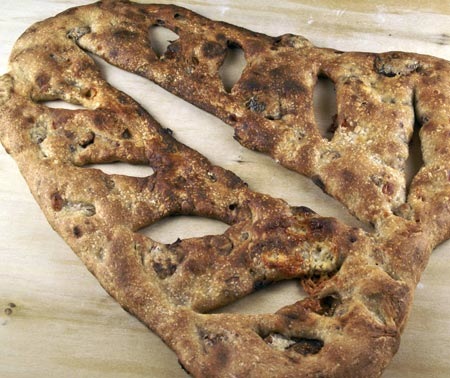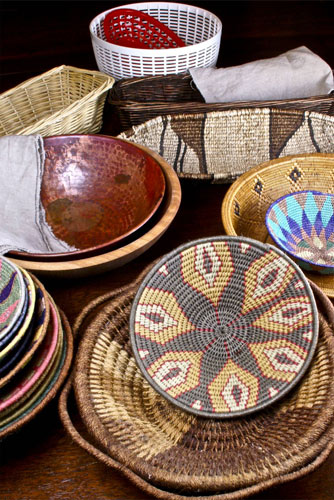What makes you cry?
For me it’s some of the usual suspects: onions, weddings, funerals, my son’s music, my daughter’s dancing.
As of yesterday, it’s also Presidential inaugurations. Congratulations, Mr. President. We are with you.
Notes from my kitchen, in which I bake bread and raise a few other matters
What makes you cry?
For me it’s some of the usual suspects: onions, weddings, funerals, my son’s music, my daughter’s dancing.
As of yesterday, it’s also Presidential inaugurations. Congratulations, Mr. President. We are with you.
 The judges for Well Fed Network’s 2008 Food Blog Awards have announced their finalist picks, and I’m delighted and honored that Wild Yeast is among five in the running for Best Food Blog – Theme. Thank you to Well Fed, and to Margie (CoffeeGrounded), who nominated me.
The judges for Well Fed Network’s 2008 Food Blog Awards have announced their finalist picks, and I’m delighted and honored that Wild Yeast is among five in the running for Best Food Blog – Theme. Thank you to Well Fed, and to Margie (CoffeeGrounded), who nominated me.
If you’d like to cast a vote for Wild Yeast or one of the other excellent theme blogs — Lunch In a Box, Karina’s Kitchen, Prudence Pennywise, and Hunter Angler Gardener Cook — the polls are open until 8PM EST on January 24.
Also, be sure to take a look at the 13 other categories, where you’ll no doubt find some of your already-favorite blogs as well as some new gems to whet your appetite.
Thank you for voting, for reading, and for making this blog so much fun to write!
I took this photo at the Marché Saxe-Breteuil in Paris, in April of 2007. Per the sign, the Pain de Campagne was 8.86 euros per kilo (that’s $5.36 a pound).
I’m sending this one to Bee and Jai (jugalbandi) for their Red-themed January Click! photo event.

Fougasse, the French version of focaccia, is a flat bread that is cut to resemble a tree, leaf, or ladder. Because the cuts maximize surface area, this is yet another type of loaf that is wonderful for crust lovers like my husband. The dough usually contains olive oil, and may have additions or fillings such as fresh herbs, cheese, nuts, olives, or anchovies.
I chose to make mine really cheesy with Gorgonzola, and added some pecans and figs to make it extra decadent. I know it’s not much to look at, but please take my word for it — it it tastes a lot better than it looks. Just to be clear, it’s really cheesy.
Since I was going for crispy as well as cheesy, I flattened the dough to about 1/4-inch thick. If you want it a little softer in the middle, you could make it thicker. Also, depending on the size and shape of your stone, you may need to make the fougasse a little more square or circular rather than elongated like mine. For more options on how to shape and cut a fougasse, take a look at these from Mon Blog Loisirs and Living in the Kitchen With Puppies.
I have found that it’s much easier to make clean cuts by exerting straight downward pressure on the dough (guillotine-style), rather than dragging a blade through it. I use a small rigid plastic dough scraper, but the end of a square metal spatula would work as well.
The folds of a couche (a piece of stiff linen) are ideal for cradling and supporting proofing baguettes and batards. But how do you transfer the proofed loaves onto a peel so you can get them into the oven?
Flipping board to the rescue. A flipping board is nothing more than a narrow piece of wood onto which the loaf is gently rolled off the couche, and from which the loaf is then either rolled or slid onto the peel.
In the video below, I use a 27 x 4-inch board to transfer baguettes onto a piece of parchment on my plywood board “peel.” (I will slide the parchment, loaded with three baguettes, onto the baking stone in the oven.)
These baguettes have been proofing seam-side-down in the couche, and I want them to wind up seam-side-down on the parchment. To do this, I lift the edge of the couche to roll the baguette onto the flipping board, so it’s now seam-side-up. Then I roll the baguette off the edge of the flipping board onto the parchment, so it’s seam-side-down again.
[qt:http://www.wildyeastblog.com/wp-content/uploads/2009/01/flipping.mov 480 360]
(If you can’t see the video here, view it on YouTube.)

A while ago I wrote about brotforms, the German coiled cane proofing baskets that leave a spiral pattern on the crust of your loaf. What if you don’t have a brotform, or don’t want that spiral pattern? A banneton, French cousin to the brotform, is a woven wicker basket that usually has a linen fabric liner sewn into it.
A basket provides support for a proofing loaf; the linen liner reduces sticking and yields a smoother crust than an unlined basket. While I do proof most of my boules and batards in linen-lined baskets, they’re not official bannetons. Instead, I use loose pieces of natural unbleached linen that I lay inside of whatever basket or other vessel I want to use use for proofing. This works very well and has quite a few advantages over sewn-in liners:
It’s flexible. Any basket or bowl can be used; you don’t need special “proofing baskets.” I have been known to use decorative wicker or sisal baskets; the basket from my salad spinner; plastic chip baskets; and salad and mixing bowls made from wood, ceramic, plastic, or metal. Whatever size you need, you probably already have it around the house. Of course if you already have a brotform, you can lay a linen liner in that too, if you feel like it.